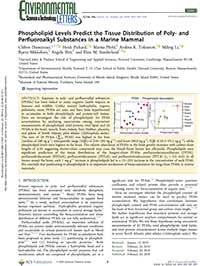 Dassuncao, Clifton, Heidi Pickard, Marisa Pfohl, Andrea K. Tokranov, Miling Li, Bjarni Mikkelsen, Angela Slitt, and Elsie M. Sunderland. Phospholipid Levels Predict the Tissue Distribution of Poly- and Perfluoroalkyl Substances in a Marine Mammal. Environmental Science & Technology Letters (2019). DOI: 10.1021/acs.estlett.9b00031
Dassuncao, Clifton, Heidi Pickard, Marisa Pfohl, Andrea K. Tokranov, Miling Li, Bjarni Mikkelsen, Angela Slitt, and Elsie M. Sunderland. Phospholipid Levels Predict the Tissue Distribution of Poly- and Perfluoroalkyl Substances in a Marine Mammal. Environmental Science & Technology Letters (2019). DOI: 10.1021/acs.estlett.9b00031
Exposure to poly- and perfluoroalkyl substances (PFAS) has been linked to many negative health impacts in humans and wildlife. Unlike neutral hydrophobic organic pollutants, many PFAS are ionic and have been hypothesized to accumulate in both phospholipids and protein-rich tissues. Here we investigate the role of phospholipids for PFAS accumulation by analyzing associations among concurrent measurements of phospholipid, total protein, total lipid, and 24 PFAS in the heart, muscle, brain, kidney, liver, blubber, placenta, and spleen of North Atlantic pilot whales (Globicephala melas). The sum of 24 PFAS (∑24 PFAS) was highest in the liver [median of 260 ng g–1; interquartile range (IQR) of 216–295 ng g–1] and brain (86.0 ng g–1; IQR of 54.5–91.3 ng g–1), while phospholipid levels were highest in the brain. The relative abundance of PFAS in the brain greatly increases with carbon-chain lengths of ≥10, suggesting shorter-chain compounds may cross the blood–brain barrier less efficiently. Phospholipids were significant predictors of the tissue distribution of the longest-chain PFAS: perfluorodecanesulfonate (PFDS), perfluorododecanoate (PFDoA), perfluorotridecanoate (PFTrA), and perfluorotetradecanoate (PFTA) (rs = 0.5–0.6). In all tissues except the brain, each 1 mg g–1 increase in phospholipids led to a 12–25% increase in the concentration of each PFAS. We conclude that partitioning to phospholipids is an important mechanism of bioaccumulation for long-chain PFAS in marine mammals.

